
Georg (Göran) Wahlenberg was a Swedish naturalist. He was born in Kroppa, Värmland County.

Verrucariaceae is a family of lichens and a few non-lichenised fungi in the order Verrucariales. The lichens have a wide variety of thallus forms, from crustose (crust-like) to foliose (bushy) and squamulose (scaly). Most of them grow on land, some in freshwater and a few in the sea. Many are free-living but there are some species that are parasites on other lichens, while one marine species always lives together with a leafy green alga.

Heteroplacidium is a genus of lichen-forming fungi in the family Verrucariaceae. The genus was circumscribed by Austrian lichenologist Othmar Breuss in 1996 with Heteroplacidium imbricatum assigned as the type species. It was proposed as a segregate of Catapyrenium. Other morphologically similar genera are Neocatapyrenium, Placidium, and Scleropyrenium, although molecular phylogenetic analyses indicate that they are independent monophyletic lineages within the Verrucariaceae.

Verrucaria is a genus of lichenized (lichen-forming) fungi in the family Verrucariaceae.
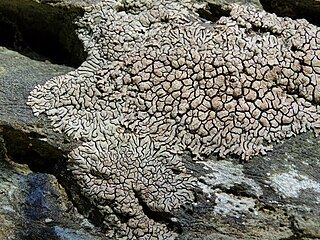
Placopyrenium is a genus of saxicolous (rock-dwelling), crustose lichens in the family Verrucariaceae.
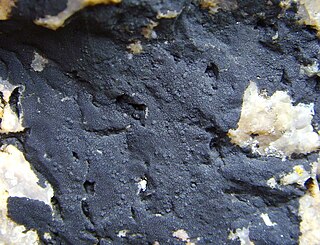
Hydropunctaria maura, still often called by the older name Verrucaria maura and commonly known as tar lichen, is a species of saxicolous (rock-dwelling), crustose lichen belonging to the family Verrucariaceae. A perennial species that does not experience seasonal variations, it is the type species of the genus Hydropunctaria. The medulla is a black basal layer that forms columns to the upper surface and isolates the algae into pockets near the upper surface. The black band formed by H. maura can often be seen at a distance as a marker of the high water point.
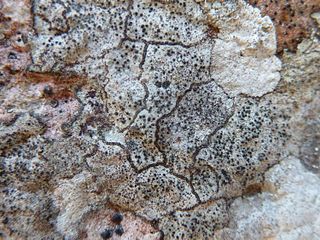
Parabagliettoa is a genus of crustose lichens in the family Verrucariaceae. It has 3 species. The genus was circumscribed in 2009 by Cécile Gueidan and Claude Roux, with Parabagliettoa dufourii assigned as the type species.
Heteroplacidium zamenhofianum is a species of lichenicolous (lichen-eating) lichen in the family Verrucariaceae. As a juvenile, it is parasitic on some members of the lichen genus Staurothele, but later becomes independent and develops a brown, crustose thallus. Characteristic features of the lichen include its dark brown, somewhat squamulous thallus and relatively small ascospores. It is widely distributed in Europe and North America.
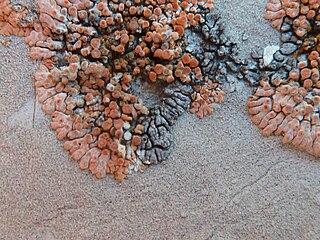
Verrucula is a genus of lichenicolous (lichen-dwelling) lichens in the family Verrucariaceae. Species in the genus are parasitic on saxicolous (rock-dwelling), crustose lichens, including Xanthoria elegans as well as lichens from genus Caloplaca that contain chemical substances called anthraquinones.
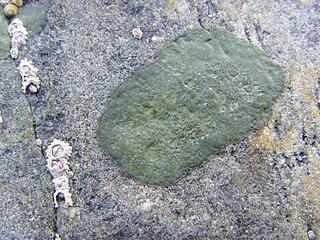
Wahlenbergiella is a genus of saxicolous (rock-dwelling), crustose lichens in the family Verrucariaceae. It has three species, all of which live in marine intertidal zones where they get periodically immersed in seawater. Wahlenbergiella closely resembles another lichen genus that includes marine species, Hydropunctaria. Wahlenbergiella was circumscribed in 2009 by Cécile Gueidan and Holger Thüs. They initially included two species: W. striatula, and the type, W. mucosa. The generic name honours Swedish naturalist Göran Wahlenberg, who originally described both of these species.

Mastodia is a genus of lichen-forming fungi in the family Verrucariaceae. It has six species.
Hydropunctaria oceanica is a species of crustose lichen in the family Verrucariaceae. It is a marine lichen. Found in Great Britain, it was formally described as a new species in 2012 by lichenologist Alan Orange. The type specimen was collected near Haverfordwest, where it was found growing on siliceous rocks on the seashore. It has also been recorded in Ireland. The species epithet oceanica refers to its growth near the ocean. The lichen is similar in appearance, and often grows contiguously with the common and widespread littoral zone lichen Hydropunctaria maura, but is genetically distinct from that species.
Hydropunctaria orae is a species of saxicolous (rock-dwelling), crustose lichen in the family Verrucariaceae. It is a marine lichen. Found in Great Britain, it was formally described as a new species in 2012 by lichenologist Alan Orange. The type specimen was collected near Haverfordwest, where it was found growing on steep rocks on northwest-facing seashore. It has also been recorded in Ireland. The species epithet orae is derived from the Latin ora. The lichen has a thin, dull mid green to dark greenish-grey thallus that is roughened by tiny warts (punctae) measuring 20–40 μm wide.
Hydropunctaria rheitrophila is a species of freshwater, saxicolous (rock-dwelling), crustose lichen in the family Verrucariaceae. It was formally described as a new species in 1922 by German lichenologist Georg Hermann Zschacke as a species of Verrucaria. Christine Keller, Cécile Gueidan, and Holger Thüs transferred it to the newly circumscribed genus Hydropunctaria in 2009. It is one of several aquatic lichens that are in this genus. The photobiont partner of Hydropunctaria rheitrophila is a yellow-green alga.
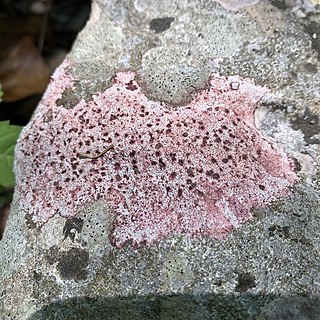
Bagliettoa marmorea is a species of saxicolous (rock-dwelling), crustose lichen in the family Verrucariaceae. It is endolithic on calcareous rocks, meaning it grows under and around the rock crystals. The colour of the lichen is purple to pink, although sometimes it is grey with purple pigments visible only around the perithecia. It does not have a shield-shaped involucrellum, which is typical of several other species in genus Bagliettoa. The excipulum measures 0.2–0.3 mm in diameter and lacks colour other than the upper part, which is purple. Ascospores are 13–30 by 9–15 μm.
Trimmatothele is a genus of saxicolous (rock-dwelling), crustose lichens in the family Verrucariaceae. It has five species. The genus was formally published by lichenologist Alexander Zahlbruckner in 1903. The type species, Trimmatothele perquisita, was originally collected from Norway by Johannes M. Norman, who placed it in the genus Coniothele in 1868. Diagnostic characteristics of Trimmatothele include a thin thallus with a smooth surface; small perithecia that are partially immersed in the substrata and have an involucrellum; asci that contain multiple ascospores; and small, simple ascospores. Trimmatothele has been described as one of the most poorly known genera of lichens due to the rarity of its species, the few available herbarium specimens, and some missing type specimens.

Wahlenbergiella mucosa is a species of saxicolous (rock-dwelling), crustose lichen in the family Verrucariaceae. It is a marine species that grows in the littoral zone, and therefore remains immersed in seawater for extended periods. Its photobiont partner is the green alga Paulbroadya petersii.
Wahlenbergiella tavaresiae is a species of saxicolous (rock-dwelling), crustose lichen in the family Verrucariaceae. Known from several locations in the San Francisco Bay area of the United States, it is a marine lichen that inhabits intertidal zones, and as such is immersed in seawater on a regular basis. Associated algal species include the red algae Hildenbrandia and Mastocarpus papillatus, and the brown algae Pelvetiopsis and Fucus. Petroderma maculiforme, a brown alga, is the photobiont partner in the lichen.

Verrucaria viridula is a common and widely distributed species of saxicolous (rock-dwelling), crustose lichen in the family Verrucariaceae. Although it is a somewhat morphologically variable species, two persistent distinguishing characteristics are its relatively large perithecia, which are often curved into a beak, and its large ascospores.

Hydropunctaria amphibia is a species of saxicolous (rock-dwelling), crustose lichen in the family Verrucariaceae. One of several marine lichens in the genus Hydropunctaria, is widely distributed across Europe, extending from Norway to the Mediterranean and the Iberian coasts, and has a nearly ubiquitous presence along the Catalan coast of Spain. In North America, it is found along the Atlantic Coast from Nova Scotia to the Boston Harbor islands, where its presence in low-pollution areas indicates its potential as a bioindicator for marine lichen community health, and on the west coast in British Columbia, particularly in the Gwaii Haanas's upper littoral fringe. The black, crust-like thallus grows on seashore rocks – both siliceous rocks and limestone – in the lower supralittoral zone, an area also known as the splash zone. Originally described more than two centuries ago as a species of Verrucaria, Hydropunctaria amphibia sets itself apart from other species in Hydropunctaria through the distinct shape of the perithecium apex, which is either flat-topped or scalloped, in contrast to the typically rounded or immersed apex seen in its relatives.













